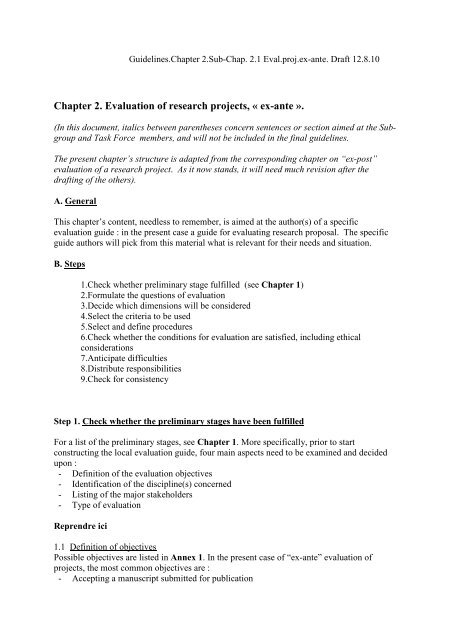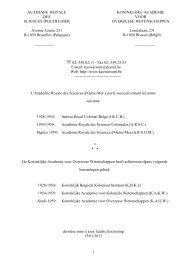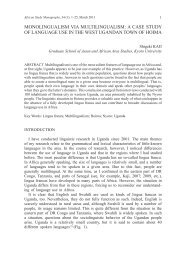Chapter 2. Evaluation of research projects, « ex-ante ».
Chapter 2. Evaluation of research projects, « ex-ante ».
Chapter 2. Evaluation of research projects, « ex-ante ».
Create successful ePaper yourself
Turn your PDF publications into a flip-book with our unique Google optimized e-Paper software.
Guidelines.<strong>Chapter</strong> <strong>2.</strong>Sub-Chap. <strong>2.</strong>1 Eval.proj.<strong>ex</strong>-<strong>ante</strong>. Draft 1<strong>2.</strong>8.10<br />
<strong>Chapter</strong> <strong>2.</strong> <strong>Evaluation</strong> <strong>of</strong> <strong>research</strong> <strong>projects</strong>, <strong>«</strong> <strong>ex</strong>-<strong>ante</strong> <strong>»</strong>.<br />
(In this document, italics between parentheses concern sentences or section aimed at the Subgroup<br />
and Task Force members, and will not be included in the final guidelines.<br />
The present chapter’s structure is adapted from the corresponding chapter on “<strong>ex</strong>-post”<br />
evaluation <strong>of</strong> a <strong>research</strong> project. As it now stands, it will need much revision after the<br />
drafting <strong>of</strong> the others).<br />
A. General<br />
This chapter’s content, needless to remember, is aimed at the author(s) <strong>of</strong> a specific<br />
evaluation guide : in the present case a guide for evaluating <strong>research</strong> proposal. The specific<br />
guide authors will pick from this material what is relevant for their needs and situation.<br />
B. Steps<br />
1.Check whether preliminary stage fulfilled (see <strong>Chapter</strong> 1)<br />
<strong>2.</strong>Formulate the questions <strong>of</strong> evaluation<br />
3.Decide which dimensions will be considered<br />
4.Select the criteria to be used<br />
5.Select and define procedures<br />
6.Check whether the conditions for evaluation are satisfied, including ethical<br />
considerations<br />
7.Anticipate difficulties<br />
8.Distribute responsibilities<br />
9.Check for consistency<br />
Step 1. Check whether the preliminary stages have been fulfilled<br />
For a list <strong>of</strong> the preliminary stages, see <strong>Chapter</strong> 1. More specifically, prior to start<br />
constructing the local evaluation guide, four main aspects need to be <strong>ex</strong>amined and decided<br />
upon :<br />
- Definition <strong>of</strong> the evaluation objectives<br />
- Identification <strong>of</strong> the discipline(s) concerned<br />
- Listing <strong>of</strong> the major stakeholders<br />
- Type <strong>of</strong> evaluation<br />
Reprendre ici<br />
1.1 Definition <strong>of</strong> objectives<br />
Possible objectives are listed in Ann<strong>ex</strong> 1. In the present case <strong>of</strong> “<strong>ex</strong>-<strong>ante</strong>” evaluation <strong>of</strong><br />
<strong>projects</strong>, the most common objectives are :<br />
- Accepting a manuscript submitted for publication
- Continuous funding (<strong>of</strong> same project; <strong>of</strong> new proposal)<br />
- Granting a degree<br />
- Recognition : award, prize)<br />
- Valorisation<br />
1.2 Identification <strong>of</strong> disciplines concerned<br />
See Ann<strong>ex</strong> 2<br />
Specify how to operate in the case <strong>of</strong> a multidisciplinary <strong>research</strong><br />
1.3 Listing <strong>of</strong> the major stakeholders<br />
See Ann<strong>ex</strong> .3<br />
1.4 Type <strong>of</strong> evaluation<br />
Enounce clearly whether<br />
- <strong>Evaluation</strong> was planned from the stage <strong>of</strong> project design on<br />
- Participatory, or <strong>ex</strong>ternal evaluation, or both.<br />
Step <strong>2.</strong> Formulate the questions <strong>of</strong> evaluation<br />
Express concisely and with simple words<br />
- What does the evaluator want to know <br />
- What for <br />
(This still needs to be worked out by the Sub-group)<br />
Step 3. Decide which dimensions will be considered<br />
<strong>Evaluation</strong> <strong>of</strong> a <strong>research</strong> project is necessarily multidimensional. Hence the need to carefully<br />
choose the dimensions to be taken into consideration in each specific evaluation guide.<br />
The basic dimensions <strong>of</strong> evaluation <strong>of</strong> a development <strong>research</strong> project, “<strong>ex</strong>-post” are :<br />
- Relevance for development<br />
- Scientific quality<br />
- Valorisation<br />
- Performance<br />
- Impact on development<br />
Other dimensions may also be considered, depending upon the cont<strong>ex</strong>t and upon the<br />
objectives <strong>of</strong> the evaluation. Examples :<br />
- Innovation; originality<br />
- Comprehensiveness<br />
- Cost effectiveness<br />
- Appropriation (<strong>of</strong> the results )<br />
- Sustainability<br />
The last two dimensions may <strong>of</strong>ten be given a higher weight, particularly when an applied<br />
<strong>research</strong> project with a clear development goal will be evaluated.
See Ann<strong>ex</strong> 4 for details.<br />
Step 4. Select the criteria to be used in the specific evaluation guide<br />
(This section should <strong>ex</strong>plain two processes :<br />
- the choice <strong>of</strong> criteria on the basis <strong>of</strong> the selected dimensions<br />
- the principles and rules for giving relative weights to the criteria, when necessary.<br />
Details to be covered here and in step 5 Procedures)<br />
Step 5. Select and define evaluation procedures<br />
(This section will depend on decisions made during steps 1 (sub-step 1.4) and step 4. To be<br />
written when the guidelines and the ann<strong>ex</strong>es are more advanced).<br />
See Ann<strong>ex</strong> 5<br />
Step 6. Check whether the conditions for a meaningful evaluation are satisfied,<br />
including ethical considerations<br />
This step must be included in each specific evaluation guide. Yet the conditions <strong>of</strong> evaluation<br />
are quite general and are <strong>of</strong>ten common to many situations.<br />
The guidelines’ users will find the necessary guidance in Ann<strong>ex</strong> 6.<br />
Step 7. Anticipate potential difficulties<br />
This step will <strong>of</strong>ten prove helpful to the specific guide’s user, that is the evaluator himself.<br />
Mistakes, pitfalls or drawbacks he may face will be identified, and manners <strong>of</strong> overcoming<br />
them will be proposed. Examples are :<br />
- Criteria in the guide are ambiguous, or difficult to interpret (because for instance the<br />
instructions for use are not clear or not complete)<br />
- Inadequate information on the data or on the way they were calculated<br />
- Biases : the conditions for a good evaluation are not fully satisfied<br />
- Lack <strong>of</strong> transparency<br />
- Conflicts <strong>of</strong> interest. Appeal to the evaluator’s ethics is sometimes needed in order to<br />
prevent or correct such biases<br />
- Results <strong>of</strong> evaluation are used for a purpose which does not correspond to the stated<br />
evaluation objectives<br />
- Etc.<br />
Step 8. Distribute responsibilities<br />
The specific evaluation guide will define who, among the actors which were identified at<br />
start, will do what.
This applies to the specific guide authors as well as to the actual evaluators.<br />
Step 9. Check for consistency<br />
Return to <strong>Chapter</strong> 1 (Preliminary stages) and make sure all the indications contained in<br />
<strong>Chapter</strong> 1. have been given due consideration. That does not mean, obviously, that all have to<br />
be adopted. Proceed iteratively.<br />
________________________________________
















